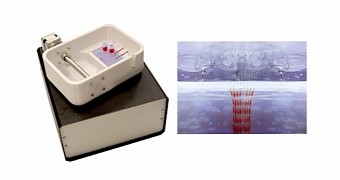For years now it has become clear that 3D bioprinting would play a huge role in further research and discovery of new medical treatments and surgical techniques, and a team from the University of Toronto may have come up with one of the most promising applications yet: the PrintAlive Bioprinter.
So far, 3D printing technology has mostly been used for bone and organ models, to allow surgeons to more easily plan their operations and such.
However, 3D bioprinting has been showing its worth as well, enabling customized bone/metal implants, replacement joints, even 3D printed livers (although, admittedly, they've only been used in drug tests for now).
However, everyone is still anticipating the day when 3D printing technology successfully produces tissue or organs that are actually implantable/transplantable.
The team from the University of Toronto haven't managed that, but they have invented something almost as good: living bandages.
The PrintAlive 3D Bioprinter
This machine was created by a group of biomedical and mechanical engineering graduate students at the University of Toronto.
The 3D printer produces artificial skin grafts for burn victims, which act as living bandages. The grafts are made of a biopolymer, but are also infused with human keratinocytes, the most common cells in the epidermis (they compose 90% of skin) and fibroblasts (maintain structural integrity of connective tissues).
Thus, these “living bandages” can be used to treat even severe burn injuries very quickly. And it is not just a hasty patch job, but a method that can significantly accelerate healing in addition to saving the life of the victim (since the bandages can help heal both the outer and inner layers of the skin).
Arianna McAllister and Lian Leng have already been awarded the top prize in the Canadian leg of the 2014 James Dyson Award for their creation (it is an international student product design contest).
How it works
The PrintAlive 3D Bioprinter uses a new process developed by Arianna McAllister and Lian Leng, called microfluidic cartridge-based technology, which produces hydrogel sheets with more than one cell type. The technique allows for control of the graft thickness, composition, and structure.
All in all, the 3D printed skin grafts not only allow for lives to be saved and skin to be healed without as much lasting damage as usual, but they also need far fewer donor cells. In fact, by using patients' own cells, McAllister hopes to eliminate all possibility of the graft being rejected (a common immunologic reaction).

 14 DAY TRIAL //
14 DAY TRIAL //